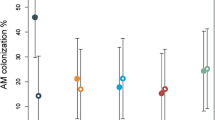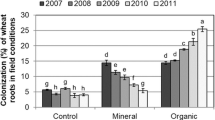Abstract
Few field studies have investigated the contribution of arbuscular mycorrhizal fungi (AMF) to agricultural systems. In this study, the role of AMF in nutrition and yield of dryland autumn-sown wheat and field pea was examined through a 2-year crop sequence experiment on a red loam (Kandosol) in SE Australia. The soil was P-deficient and had low levels of root pathogens. In Year 1, levels of AMF were increased by growing subterranean clover or LinolaTM and decreased by growing canola or through maintenance of bare fallow with herbicides or tillage. In Year 2, hosts of AMF (wheat and field pea) and non-mycorrhizal canola were grown with 0 P or 20 kg ha−1 of P as superphosphate. Yields of all Year 2 crops were increased by P-fertiliser. Year 1 treatment led to 2–3 fold variation in colonisation by AMF at each P-level for Year 2 wheat and field pea. High colonisation did not correspond with greater crop growth, yield, or uptake of P, K, Ca, Cu or S in wheat or field pea. However, total crop Zn-uptake and grain Zn concentration were positively correlated with colonisation by AMF, due to enhanced Zn-uptake after anthesis. For wheat, high colonisation also corresponded with reduced Mn-uptake and lower grain Mn concentrations. In a glasshouse experiment using a second P-deficient Kandosol, inoculation of wheat with Glomus intraradices and Scutellospora calospora enhanced uptake of Zn and P when no P-fertiliser was applied. We conclude that high colonisation by AMF is unimportant for productivity of the major field crops grown on the Kandosol soils that occupy large areas of cropland in temperate SE Australia, even under P-limiting conditions. Investigation of the factors that control functioning of arbuscular mycorrhizae under field conditions, especially temperature, is required.
Similar content being viewed by others
References
Angus J F, Gault R R, Peoples M B, Stapper M and van Herwaarden A F 2001 Soil water extraction by dryland crops, annual pastures, and lucerne in south-eastern Australia. Aust. J. Agric. Res. 52, 183–192.
Auge R M, Stodola A J W, Tims J E and Saxton A M 2001 Moisture retention properties of a mycorrhizal soil. Plant Soil 230, 87–97.
Connell P and Hooper S 2002 Australian Grains Industry 2002. Report of the Australian Agricultural and Grazing Industries Survey of Grain Farms. Australian Bureau of Agricultural and Resource Economics, Canberra. 45 pp.
Cooke J W, Ford G W, Dumsday R G and Willatt S T 1985 Effect of fallowing practices on the growth and yield of wheat in southeastern Australia. Aust. J. Exp. Agric. 25, 614–627.
Cooper K M and Tinker P B 1981 Translocation and transfer of nutrients in vesicular-arbuscular mycorrhizas IV. Effect of environmental variables onmovement of phosphorus. New Phytol. 88, 327–339.
Daniels Hetrick B A, Thompson Wilson G, Gerschefske Kitt D and Schwab A P 1988 Effects of soil microorganisms on mycorrhizal contribution to growth of big bluestem grass in non-sterile soil. Soil Biol. Biochem. 20, 501–507.
Dann P R, Derrick J W, Dumaresq D C and Ryan M H 1996 The response of organic and conventionally grown wheat to superphosphate and reactive rock phosphate. Aust. J. Exp. Agric. 36, 71–78.
Fischer R A 1979 Growth and water limitation to dryland wheat yield in Australia: a physiological framework. J. Aust. Instit. Agric. Sci. 45, 83–94.
Fischer R A and Kohn G D 1966 The relationship of grain yield to vegetative growth and post-flowering leaf area in the wheat crop under conditions of limited soil moisture. Aust. J. Agric. Res. 17, 2281–2295.
Galvez L, Douds D D, Drinkwater L E and Wagoner P 2001 Effect of tillage and farming system upon VAM fungus populations and mycorrhizas and nutrient uptake of maize. Plant Soil 228, 299–308.
Gaur A and Adholeya A 2000 On-farm production of VAM inoculum and vegetable crops in marginal soil amended with organic matter. Trop. Agric. (Trinidad) 77, 21–26.
Giovannetti M and Mosse B 1980 An evaluation of techniques for measuring VAM infection in roots. New Phytol. 84, 489–500.
Grace C and Stribley D P 1991 A safer procedure for routine staining of vesicular arbuscular mycorrhizal fungi. Mycol. Res. 95, 1160–1162.
Graham R D, Humphries J M and Kitchen J L 2000 Nutritionally enhanced cereals: a sustainable foundation for a balanced diet. Asia Pac. J. Clinical Nutr. 9 (Suppl), S91–S96.
Green A G 1995 Register of Australian oilseed cultivars Linum usitatissimum (L.) (linseed) cv. Wallaga. Aust. J. Exp. Agric. 35, 120.
Hamel C 1996 Prospects and problems pertaining to the management of arbuscular mycorrhizae in agriculture. Agric. Ecosyst. Environ. 60, 197–210.
Hutton J T and Norrish K 1977 Plant analyses by X-ray spectrometry. II. Elements of atomic number greater than 20. X-Ray Spectrometry 6, 12–17.
Isbell R F 1996 The Australian Soil Classification. CSIRO Publishing, Melbourne. 145 pp.
Jakobsen I 1986 Vesicular-arbuscular mycorrhiza in field-grown crops III. Mycorrhizal infection and rates of phosphorus inflow in pea plants. New Phytol. 104, 573–581.
Jakobsen I, Gazey C and Abbott L K 2001 Phosphate transport by communities of arbuscular mycorrhizal fungi in intact cores. New Phytol. 149, 95–103.
Jensen A 1984 Responses of barley, pea, and maize to inoculation with different vesicular-arbuscular mycorrhizal fungi in irradiated soil. Plant Soil 78, 315–323.
Johnson N C 1993 Can fertilization of soil select less mutualistic mycorrhizae? Ecol. Applications 3, 749–757.
Kahiluoto H, Ketoja E, Vestburg M and Saarela I 2001 Promotion of AMutilization through reduced P fertilisation 2. Field studies. Plant Soil 231, 65–79.
Khaliq A and Sanders F E 2000 Effects of vesicular-arbuscular mycorrhizal inoculation on the yield and phosphorus uptake of field-grown barley. Soil Biol. Biochem. 32, 1691–1696.
Khan A G 1975 The effect of vesicular-arbuscular mycorrhizal associations on growth of cereals II. Effects on wheat. Ann. Appl. Biol. 80, 27–36.
King P M, McCloud P I, Jacka J and Graham R D 1992 Crops and pasture rotations in Coonalpyn, South Australia: effects on nutrients in wheat and barley. J. Agron. Crop Sci. 168, 37–48.
Kirkegaard J A, Gardner P A, Angus J F and Koetz E 1994 Effect of Brassica break crops on the growth and yield of wheat. Aust. J. Agric. Res. 45, 529–545.
Kirkegaard J A, Sarwar M, Wong P T W, Mead A, Howe G and Newell M 2000 Field studies on the biofumigation of take-all by Brassica break crops. Aust. J. Agric. Res. 51, 445–456.
Kothari S K, Marschner H and George E 1990a Effect of VA mycorrhizal fungi and rhizosphere microorganisms on root and shoot morphology, growth and water relations in maize. New Phytol. 116, 303–311.
Kothari S K, Marschner H and Romheld V 1990b Direct and indirect effects of VA mycorrhizal fungi and rhizosphere microorganisms on acquisition of mineral nutrients by maize (Zea mays L.) in a calcareous soil. New Phytol. 116, 637–645.
Kothari S K, Marschner H and Romheld V 1991 Effect of a vesicular-arbuscular mycorrhizal fungus and rhizosphere microorganisms on manganese reduction in the rhizosphere and manganese concentrations in maize. New Phytol. 117, 649–655.
Mohammad M J, Pan W L and Kennedy A C 1998 Seasonal mycorrhizal colonisation of winter wheat and its effect on wheat growth under dryland field conditions. Mycorrhiza 8, 139–144.
Mozafar A, Anken T, Ruh R and Frossard E 2000 Tillage intensity, mycorrhizal and nonmycorrhizal fungi, and nutrient concentrations in maize, wheat and canola. Agron. J. 92, 1117–1124.
Nambiar E K S 1977 The effects of water content of the topsoil on micronutrient availability and uptake in a siliceous sandy soil. Plant Soil 46, 175–183.
Norrish K and Hutton J T 1977 Plant analysis by X-ray spectrometry. I. Low atomic number elements, sodium to calcium. X-Ray Spectrometry 6, 6–17.
Peoples M B and Herridge D F 1990 Nitrogen fixation by legumes in tropical and subtropical agriculture. Adv. Agron. 44, 155–223.
Peoples M B, Turner G L, Shah Z, Shah S H, Aslam M, Ali S, Maskey S L, Bhattarai S, Afandi F, Schwenke G D and Herridge D F 1997 Evaluation of the 15N natural abundance technique to measure N2 fixation in experimental plots and farmers fields. In Extending Nitrogen Fixation Research to Farmer's Fields. Eds. O P Rupela, C Johansen and D F Herridge. pp. 57–75. ICRISAT, Andhra Pradesh.
Rayment G E and Higginson F R 1992 Australian Laboratory Handbook of Soil and Water Chemical Methods. Inkata Press, Melbourne. 330 pp.
Rengel Z and Graham R D 1995 Importance of seed Zn content for wheat growth on Zn-deficient soil I. Vegetative growth. Plant Soil 173, 259–266.
Reuter D J and Robinson J B 1997 Plant Analysis: An Interpretation Manual. CSIRO, Collingwood. 572 pp.
Ryan M H and Graham J H 2002 Is there a role for arbuscular mycorrhizal fungi in production agriculture? Plant Soil 244, 263–271.
Ryan M H, Norton R M, Kirkegaard J A, McCormick K M, Knights S E and Angus J F 2002 Increasing mycorrhizal colonisation does not improve growth and nutrition of wheat on Vertosols in south-eastern Australia. Aust. J. Agric. Res. 53, 1173–1181.
Simpfendorfer S, Kirkegaard J A, Heenan D P and Wong P T W 2002 Reduced early growth of direct drilled wheat in southern New South Wales – role of root inhibitory pseudomonads. Aust. J. Agric. Res. 53, 323–313.
Smith S E and Read D J 1997 Mycorrhizal Symbiosis. Academic Press, San Diego. 605 pp.
Thingstrup I, Rubæk G, Sibbesen E and Jakobsen I 1998 Flax (Linum usitatissimum L.) depends on arbuscular mycorrhizal fungi for growth and P uptake at intermediate but not high soil P levels in the field. Plant Soil 203, 37–46.
Thompson J P 1987 Decline of vesicular-arbuscular mycorrhizas in long fallow disorder of field crops and its expression in phosphorus deficiency in sunflower. Aust. J. Agric. Res. 38, 847–867.
Thompson J P 1990 Soil sterilisation methods to show VAmycorrhizal aid P and Zn nutrition of wheat in vertisols. Soil Biol. Biochem. 22, 229–240.
Thompson J P, Owen K J and Clewett T G 2001 Pre-cropping with canola decreases vesicular arbuscular mycorrhizas and growth of wheat in a low phosphorus soil. Proceedings of the 2nd Australasian Soil Borne Disease Symposium. pp. 150–151. Lorne, Australia.
Thongbai P, Hannam J, Graham R and Webb M J 1993 Interaction between zinc nutritional status of cereals and Rhizoctonia root rot severity I. Field observations. Plant Soil 153, 207–214.
van Herwaarden A F, Farquhar G D, Angus J F, Richards R A and Howe G N 1998 'Haying-off', the negative grain yield response of dryland wheat to nitrogen fertiliser I. Biomass, grain yield and water use. Aust. J. Agric. Res. 49, 1067–1081.
Weber E, Saxena M C, George E and Marschner H 1993 Effect of vesicular-arbuscular mycorrhiza on vegetative growth and harvest index of chickpea grown in northern Syria. Field Crops Res. 32, 115–128.
Wright S F and Upadhyaya A 1998 A survey of soils for aggregate stability and glomalin, a glycoprotein produced by hyphae of arbuscular mycorrhizal fungi. Plant Soil 198, 97–107.
Author information
Authors and Affiliations
Corresponding author
Rights and permissions
About this article
Cite this article
Ryan, M., Angus, J. Arbuscular mycorrhizae in wheat and field pea crops on a low P soil: increased Zn-uptake but no increase in P-uptake or yield. Plant and Soil 250, 225–239 (2003). https://doi.org/10.1023/A:1022839930134
Issue Date:
DOI: https://doi.org/10.1023/A:1022839930134




